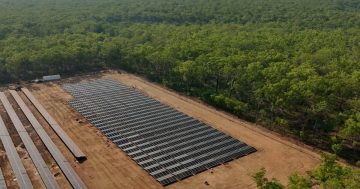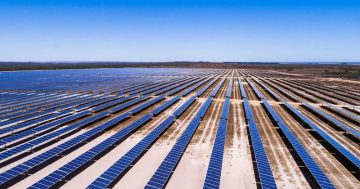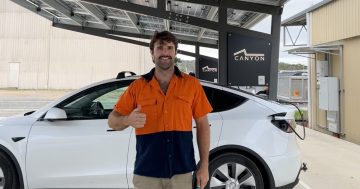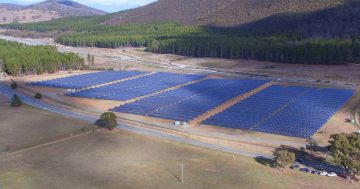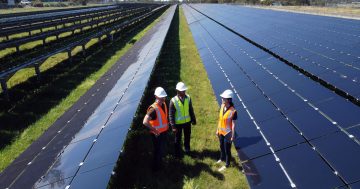James Purtill* discusses how rooftop solar on skyscrapers and the MCG could help Melbourne get to net zero
 With Australia now committed to net zero domestic emissions of greenhouse gases by 2050, the focus is on how to achieve that — from the national scale down to the state and city levels.
With Australia now committed to net zero domestic emissions of greenhouse gases by 2050, the focus is on how to achieve that — from the national scale down to the state and city levels.
What would it take, for instance, for an Australian city to be net zero?
Monash University researchers have been looking at a part of this puzzle; by mapping sunlight in the City of Melbourne, they’ve calculated how much solar energy this urban area could produce.
The research, published in the journal Solar Energy, finds that by crowding the sunny-enough rooftops with photovoltaic panels, the city centre could meet about two thirds of its energy needs.
Replacing the facades and glazing with high-tech solar-panel walls and windows would bring that figure up to three quarters.
Jacek Jasieniak, a professor of engineering at Monash and a co-author of the study, says turning the dense cluster of energy-guzzling towers into vertical solar arrays makes net zero cities achievable.
“Cities are thought of as massive energy users, but are never conceived as massive energy producers,” he said.
“All of a sudden, you can see that a city can actually do both.”
So why is the solar uptake on office towers currently so low, and what else would be required to make a city net zero?
Mapping a city’s annual sunlight
The Monash research focused on the 37-square-kilometre central area of Melbourne, which includes high-rise developments in Southbank and Docklands, mid-rise apartment towers in South Yarra and North Melbourne, and industrial low-rise in areas like Port Melbourne.
This relatively small area accounts for a whopping 7.5 per cent of Victoria’s total electricity consumption, or 3,200 GWh per year.
But it produces relatively little energy of its own: rooftop PV uptake is low.
To calculate how much solar electricity this area could produce, the researchers had to know the amount of solar radiance, or sunlight, that fell on the buildings over a year.
To do this, they developed a 3D model of the city that included the shadows cast by the buildings over the course of a day.
Now they could work out which rooftops, walls and windows would be sunny enough for photovoltaics, said Maria Panagiotidou, a co-author of the paper, private sustainability expert and Monash research fellow.
“We set a threshold for solar radiation of 1,000 kilowatt hours per square metre per year, because who would install a PV in an area where there’s not enough radiation?” she said.
They concluded the City of Melbourne’s total solar potential was 2,354 GWh per year, or 75 per cent of the city’s current consumption.
Most (88 per cent) of the energy generated would come from rooftop solar panels.
According to Professor Jasieniak, the level of installed capacity in Melbourne CBD, which is at 13.7 MW, is a “fraction of the potential capacity that the city can offer based on this work.”
Why not just use a solar farm?
This begs the question: why not just import the energy?
The arguments for generating energy locally come down to cost and resilience, Professor Jasieniak said.
Up to 20 per cent of electricity is lost by the lengthy process of sending it down kilometres of wire and cables from the power plant to the socket.
Transmission itself accounts for about 40 per cent of the cost of electricity.
Buildings with solar panels can keep operating through grid power outages, which means offices don’t have to shut down.
“There is a risk that if you get transmission line problems in Victoria, you’re going to get blackouts,” Professor Jasieniak said.
If rooftop solar panels are so good, why do so few office towers and apartment blocks have them?
One reason may be they tend to be rented, Professor Jasieniak said.
“Developers want to build cheap, so they build as cheaply as possible to sell to someone that ultimately rents the building.
“There’s no clear responsibility on who is mandated to actually put on photovoltaics.
“There’s a massive policy challenge here.”
How much could our cities generate?
From 2017-2019, the Australian Photovoltaic Institute (APVI) released a series of reports estimating the solar potential of the CBDs of most of Australia’s capital cities.
It found all were generating only a fraction of their potential.
The APVI also looked at how much energy particular buildings could generate.
Central Station in Sydney decked with solar panels would have a capacity of 3,000 kW, equivalent to about 400 average-sized household rooftop solar arrays.
Given a solar panel makeover, the Melbourne Cricket Ground (MCG) could generate up to 2,200 kW of solar energy, and the Australian War Memorial in Canberra could produce 1,200 kW.
APVI secretary Renate Egan, a UNSW solar expert, says “big public buildings” are ideal for rooftop solar.
Some buildings, however, are too tall and narrow.
She doubted any city would get close to generating three quarters or even half of its energy needs; they’d rely mostly on solar and wind farms.
“The cost of utility-scale solar will continue to fall as we keep accessing economies of scale,” she said.
But local generation will still be cost effective for some buildings.
“In CBDs, there’s still significant room for improvement — there’s now 1-2 per cent demand being met with rooftop solar when it could be 10-20 per cent,” she said.
How can our cities get to net zero?
Making a city net zero requires more than substituting solar panels for coal-fired power plants.
Another big job is “decarbonising buildings,” says Anna Skarbek, chief executive officer of the non-profit ClimateWorks.
“Buildings and transport are the major sources of emissions in cities,” she said.
Buildings will have to be retrofitted with better insulation and more energy-efficient equipment that runs on electricity, rather than gas or oil, Ms Skarbek says.
New buildings will have to be built to a higher energy efficiency standard — proposed changes to the National Construction Code 2022 would increase the minimum thermal performance of new homes from six stars to seven.
“About half the buildings that will be operating in 2050 are not yet built,” Ms Skarbek said.
“Our research shows that the code could go up to eight stars, and still benefit households who would save hundreds of dollars a year in avoided energy costs.”
Monash University is working through these problems at a smaller scale by transitioning its Australian operations to zero emissions by 2030.
The biggest problems aren’t technology, but deployment and coordination, says Scott Ferraro, the director of the university’s Net Zero Initiative.
“We don’t need any new technology to enable a net zero city.
“We just need commitment and resources to drive it,” he said.
With commitment, a net zero Melbourne by “2030 or 2035 is not unrealistic”.
Cities around the world are racing to reach net zero.
In Europe, this work is being coordinated by the EIT Climate-KIC non-profit, with funding from the European Union.
Speaking from the COP26 climate conference in Glasgow, Climate-KIC chief executive officer Kirsten Dunlop said none of the frontrunner European cities, including Copenhagen, Amsterdam and Madrid, are on track to be near to net zero by 2030.
“We’ve got a huge gap between what we believe is feasible and what’s actually needed,” she said.
Like Monash’s Mr Ferraro, she says the greatest challenge is not developing new kinds of low-emission technology, but deploying the existing ones.
Cities are made up of many parts interlocking in complex ways, from the different levels of government, to the private sector, to the public itself.
“Everyone knows the big problem is how to actually implement,” she said.
Australia could learn from Europe, she said.
“I do encourage Melbourne to join us, because there’s no reason why this shouldn’t be happening across the world between Europe and Australia.”
When are we getting ‘solar windows’?
You may be wondering about those high-tech solar-panel windows mentioned earlier: when are they arriving?
Solar windows are solar cells that generate electricity while allowing light to pass through.
Various window-integrated PV technologies already exist but are not efficient, meaning the costs generally outweigh the value of electricity being generated.
“We are working on different types of technologies where the efficiency is of the order of four to five times higher than what is available commercially,” Professor Jasieniak said.
“They’re still very, very early-stage technologies.
“They probably won’t be available for a decade.”
Another emerging technology is building-integrated photovoltaics (BIPV), where solar panels are built into the exterior of a building.
Basically, the idea is for the building itself to become the solar panel.
Dr Panagiotidou says these ideas should be incorporated into building design to maximise the sunny space for solar cells.
Sun and shadow should also be considered by town planners, she added.
If a proposed building will cast a shadow on existing ones and lower their solar generation potential, maybe it should go somewhere else.
“We need to figure out what’s the best design to have the largest amount of incident solar radiation on the buildings’ surfaces.”
*James Purtill works at triple j Hack in Sydney.
This article first appeared at abc.net.au.


